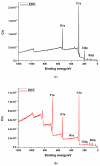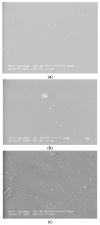Improving the Hydrophobicity of Plasticized Polyvinyl Chloride for Use in an Endotracheal Tube
- PMID: 38005019
- PMCID: PMC10672304
- DOI: 10.3390/ma16227089
Improving the Hydrophobicity of Plasticized Polyvinyl Chloride for Use in an Endotracheal Tube
Abstract
An endotracheal tube (ETT) is a greatly appreciated medical device at the global level with widespread application in the treatment of respiratory diseases, such as bronchitis and asthma, and in general anesthesia, to provide narcotic gases. Since an important quantitative request for cuffed ETTs was recorded during the COVID-19 pandemic, concerns about infection have risen. The plasticized polyvinyl chloride (PVC) material used to manufacture ETTs favors the attachment of microorganisms from the human biological environment and the migration of plasticizer from the polymer that feeds the microorganisms and promotes the growth of biofilms. This leads to developing infections, which means additional suffering, discomfort for patients, and increased hospital costs. In this work, we propose to modify the surfaces of some samples taken from commercial ETTs in order to develop their hydrophobic character using surface fluorination by a plasma treatment in SF6 discharge and magnetron sputtering physical evaporation from the PTFE target. Samples with surfaces thus modified were subsequently tested using XPS, ATR-FTIR, CA, SEM + EDAX, profilometry, density, Shore A hardness, TGA-DSC, and biological antimicrobial and biocompatibility properties. The obtained results demonstrate a successful increase in the hydrophobic character of the plasticized PVC samples and biocompatibility properties.
Keywords: attachment of microorganisms on PVC; endotracheal tube; increasing the hydrophobicity of PVC; magnetron sputtering to coat PVC with PTFE; plasma treatment in SF6 discharge; plasticized PVC in medical devices.
Conflict of interest statement
The authors declare no conflict of interest.
Figures

















Similar articles
-
Lipase degradation of plasticized polyvinyl chloride endotracheal tube surfaces to create nanoscale features.Int J Nanomedicine. 2017 Mar 16;12:2109-2115. doi: 10.2147/IJN.S130608. eCollection 2017. Int J Nanomedicine. 2017. PMID: 28352177 Free PMC article.
-
Development of S-Nitroso-N-Acetylpenicillamine Impregnated Medical Grade Polyvinyl Chloride for Antimicrobial Medical Device Interfaces.ACS Appl Bio Mater. 2019 Oct 21;2(10):4335-4345. doi: 10.1021/acsabm.9b00593. Epub 2019 Sep 17. ACS Appl Bio Mater. 2019. PMID: 35021448
-
Biofilm formation on three different endotracheal tubes: a prospective clinical trial.Crit Care. 2020 Jun 29;24(1):382. doi: 10.1186/s13054-020-03092-1. Crit Care. 2020. PMID: 32600373 Free PMC article.
-
PVC as pharmaceutical packaging material. A literature survey with special emphasis on plasticized PVC bags.Pharm Weekbl Sci. 1991 Jun 21;13(3):109-18. doi: 10.1007/BF01981526. Pharm Weekbl Sci. 1991. PMID: 1923699 Review.
-
Plasticized polyvinyl chloride: From material properties to flexible applications.Adv Colloid Interface Sci. 2025 Mar;337:103384. doi: 10.1016/j.cis.2024.103384. Epub 2024 Dec 20. Adv Colloid Interface Sci. 2025. PMID: 39729823 Review.
Cited by
-
The Collapse of Brain Clearance: Glymphatic-Venous Failure, Aquaporin-4 Breakdown, and AI-Empowered Precision Neurotherapeutics in Intracranial Hypertension.Int J Mol Sci. 2025 Jul 25;26(15):7223. doi: 10.3390/ijms26157223. Int J Mol Sci. 2025. PMID: 40806356 Free PMC article. Review.
References
-
- Strömberg E. Fibre and Polymer Technology. Royal Institute of Technology; Stockholm, Sweden: 2004. Microbiological growth testing on silicone rubber materials.
-
- Lynch J.F., Lappin-Scott H.M., Costerton J.W. Microbial Biofilms. Cambridge University Press; Cambridge, UK: 2003.
-
- Flemming H.-C. Relevance of biofilms for the biodeterioration of surfaces of polymeric materials. Polym. Degrad. Stab. 1998;59:309–315. doi: 10.1016/S0141-3910(97)00189-4. - DOI
-
- Seal K.J., Morton L.G.H. In: Chemical Materials. Schönborn W., editor. VCH; Dusseldorf, Germany: 1986. pp. 583–606.
Grants and funding
LinkOut - more resources
Full Text Sources
Miscellaneous

